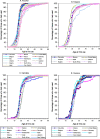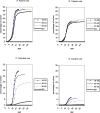Toward a global view of alcohol, tobacco, cannabis, and cocaine use: findings from the WHO World Mental Health Surveys
- PMID: 18597549
- PMCID: PMC2443200
- DOI: 10.1371/journal.pmed.0050141
Toward a global view of alcohol, tobacco, cannabis, and cocaine use: findings from the WHO World Mental Health Surveys
Abstract
Background: Alcohol, tobacco, and illegal drug use cause considerable morbidity and mortality, but good cross-national epidemiological data are limited. This paper describes such data from the first 17 countries participating in the World Health Organization's (WHO's) World Mental Health (WMH) Survey Initiative.
Methods and findings: Household surveys with a combined sample size of 85,052 were carried out in the Americas (Colombia, Mexico, United States), Europe (Belgium, France, Germany, Italy, Netherlands, Spain, Ukraine), Middle East and Africa (Israel, Lebanon, Nigeria, South Africa), Asia (Japan, People's Republic of China), and Oceania (New Zealand). The WHO Composite International Diagnostic Interview (CIDI) was used to assess the prevalence and correlates of a wide variety of mental and substance disorders. This paper focuses on lifetime use and age of initiation of tobacco, alcohol, cannabis, and cocaine. Alcohol had been used by most in the Americas, Europe, Japan, and New Zealand, with smaller proportions in the Middle East, Africa, and China. Cannabis use in the US and New Zealand (both 42%) was far higher than in any other country. The US was also an outlier in cocaine use (16%). Males were more likely than females to have used drugs; and a sex-cohort interaction was observed, whereby not only were younger cohorts more likely to use all drugs, but the male-female gap was closing in more recent cohorts. The period of risk for drug initiation also appears to be lengthening longer into adulthood among more recent cohorts. Associations with sociodemographic variables were consistent across countries, as were the curves of incidence of lifetime use.
Conclusions: Globally, drug use is not distributed evenly and is not simply related to drug policy, since countries with stringent user-level illegal drug policies did not have lower levels of use than countries with liberal ones. Sex differences were consistently documented, but are decreasing in more recent cohorts, who also have higher levels of illegal drug use and extensions in the period of risk for initiation.
Conflict of interest statement
Figures


References
-
- Ezzati M, Lopez A, Rodgers A, Vander Hoorn S, Murray C, et al. Selected major risk factors and global and regional burden of disease. Lancet. 2002;360:1347–1360. - PubMed
-
- Rehm J, Room R, Monteiro M, Gmel G, Graham K, et al. Chapter 12. Alcohol use. In: Ezzati M, Lopez AD, Rodgers A, Murray R, editors. Comparative quantification of health risks: global and regional burden of disease attributable to selected major risk factors. 2nd edition. Geneva: World Health Organization; 2004. pp. 959–1108.
-
- Degenhardt L, Hall W, Lynskey M, Warner-Smith M. Chapter 13. Illicit drug use. In: Ezzati M, Lopez AD, Rodgers A, Murray R, editors. Comparative quantification of health risks: global and regional burden of disease attributable to selected major risk factors. 2nd edition. Geneva: World Health Organization; 2004. pp. 1109–1176.
-
- Ezzati M, Lopez AD. Chapter 11. Smoking and oral tobacco use. In: Ezzati M, Lopez AD, Rodgers A, Murray R, editors. Comparative quantification of health risks: global and regional burden of disease attributable to selected major risk Factors. 2nd edition. Geneva: World Health Organization; 2004. pp. 883–957.
Publication types
MeSH terms
Grants and funding
- R01 DA016558/DA/NIDA NIH HHS/United States
- U01-MH60220/MH/NIMH NIH HHS/United States
- R03 TW006481/TW/FIC NIH HHS/United States
- R01DA016558/DA/NIDA NIH HHS/United States
- K05 DA015799/DA/NIDA NIH HHS/United States
- U01 MH060220/MH/NIMH NIH HHS/United States
- R13-MH066849/MH/NIMH NIH HHS/United States
- R01 MH070884/MH/NIMH NIH HHS/United States
- R01 MH059575/MH/NIMH NIH HHS/United States
- R01-TW006481/TW/FIC NIH HHS/United States
- R13 MH066849/MH/NIMH NIH HHS/United States
- R01-MH059575/MH/NIMH NIH HHS/United States
- R01 MH069864/MH/NIMH NIH HHS/United States
- R01-MH61905/MH/NIMH NIH HHS/United States
- R01MH070884/MH/NIMH NIH HHS/United States
- K05DA015799/DA/NIDA NIH HHS/United States
- R01 MH061905/MH/NIMH NIH HHS/United States
- R01-MH069864/MH/NIMH NIH HHS/United States
LinkOut - more resources
Full Text Sources
Other Literature Sources
Medical
Miscellaneous

